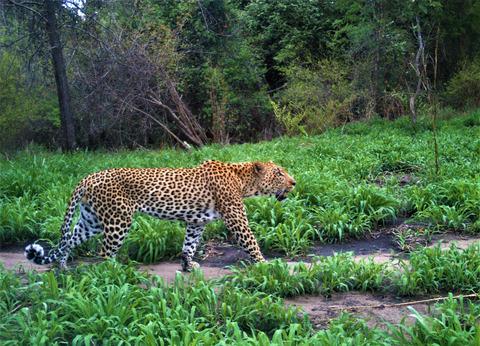Our official English website, www.x-mol.net, welcomes your
feedback! (Note: you will need to create a separate account there.)
Spatial partial identity model reveals low densities of leopard and spotted hyaena in a miombo woodland
Journal of Zoology ( IF 1.9 ) Pub Date : 2020-10-19 , DOI: 10.1111/jzo.12838 R. S. Davis 1 , E. L. Stone 2, 3 , L. K. Gentle 1 , W. O. Mgoola 4 , A. Uzal 1 , R. W. Yarnell 1
Journal of Zoology ( IF 1.9 ) Pub Date : 2020-10-19 , DOI: 10.1111/jzo.12838 R. S. Davis 1 , E. L. Stone 2, 3 , L. K. Gentle 1 , W. O. Mgoola 4 , A. Uzal 1 , R. W. Yarnell 1
Affiliation

|
Decline in global carnivore populations has led to increased demand for assessment of carnivore densities in understudied habitats. Spatial capture–recapture (SCR) is used increasingly to estimate species densities, where individuals are often identified from their unique pelage patterns. However, uncertainty in bilateral individual identification can lead to the omission of capture data and reduce the precision of results. The recent development of the two‐flank spatial partial identity model (SPIM) offers a cost‐effective approach, which can reduce uncertainty in individual identity assignment and provide robust density estimates. We conducted camera trap surveys annually between 2016 and 2018 in Kasungu National Park, Malawi, a primary miombo woodland and a habitat lacking baseline data on carnivore densities. We used SPIM to estimate density for leopard (Panthera pardus) and spotted hyaena (Crocuta crocuta) and compared estimates with conventional SCR methods. Density estimates were low across survey years, when compared to estimates from sub‐Saharan Africa, for both leopard (1.9 ± 0.19 sd adults/100 km2) and spotted hyaena (1.15 ± 0.42 sd adults/100 km2). Estimates from SPIM improved precision compared with analytical alternatives. Lion (Panthera leo) and wild dog (Lycaon pictus) were absent from the 2016 survey, but lone dispersers were recorded in 2017 and 2018, and both species appear limited to transient individuals from within the wider transfrontier conservation area. Low densities may reflect low carrying capacity in miombo woodlands or be a result of reduced prey availability from intensive poaching. We provide the first leopard density estimates from Malawi and a miombo woodland habitat, whilst demonstrating that SPIM is beneficial for density estimation in surveys where only one camera trap per location is deployed. The low density of large carnivores requires urgent management to reduce the loss of the carnivore guild in Kasungu National Park and across the wider transfrontier landscape.
中文翻译:

空间局部同一性模型揭示了密波罗林地中豹和斑点鬣狗的低密度
全球食肉动物数量的减少导致对被研究不足的栖息地食肉动物密度评估的需求增加。空间捕获-再捕获(SCR)越来越多地用于估计物种密度,而物种密度通常是根据其独特的皮毛模式来识别的。但是,双边个人识别的不确定性会导致捕获数据的遗漏并降低结果的准确性。两侧面空间局部身份模型(SPIM)的最新发展)提供了一种经济高效的方法,可以减少个人身份分配的不确定性并提供可靠的密度估计。我们在2016年至2018年之间,每年在马拉维的Kasungu国家公园(一个主要的Miombo林地和一个缺乏食肉动物密度基准数据的栖息地)中进行相机陷阱调查。我们使用SPIM来估算豹子(Panthera pardus)和斑点鬣狗(Crocuta crocuta)的密度,并将其与常规SCR方法进行比较。与来自撒哈拉以南非洲地区的估计相比,豹的密度(1.9±0.19 sd成人/ 100 km 2)和斑点鬣狗(1.15±0.42 sd成人/ 100 km 2)的密度估计值与撒哈拉以南非洲地区的估计值相比较低)。与分析替代方法相比,SPIM的估计值提高了精度。2016年的调查中没有发现狮子(Panthera leo)和野狗(Lycaon pictus),但在2017年和2018年记录了单独的分散剂,这两个物种似乎仅限于跨境保护区范围内的短暂个体。低密度可能反映了米诺博森林地区的低承载力,或者是由于密集的猎杀导致猎物供应减少的结果。我们提供了马拉维和miombo林地栖息地的第一批豹子密度估计值,同时展示了SPIM在每个位置仅部署一个摄像头陷阱的调查中,对于密度估计很有用。大型食肉动物的低密度需要紧急管理,以减少Kasungu国家公园和整个跨境景观中食肉动物行会的损失。
更新日期:2020-10-19
中文翻译:

空间局部同一性模型揭示了密波罗林地中豹和斑点鬣狗的低密度
全球食肉动物数量的减少导致对被研究不足的栖息地食肉动物密度评估的需求增加。空间捕获-再捕获(SCR)越来越多地用于估计物种密度,而物种密度通常是根据其独特的皮毛模式来识别的。但是,双边个人识别的不确定性会导致捕获数据的遗漏并降低结果的准确性。两侧面空间局部身份模型(SPIM)的最新发展)提供了一种经济高效的方法,可以减少个人身份分配的不确定性并提供可靠的密度估计。我们在2016年至2018年之间,每年在马拉维的Kasungu国家公园(一个主要的Miombo林地和一个缺乏食肉动物密度基准数据的栖息地)中进行相机陷阱调查。我们使用SPIM来估算豹子(Panthera pardus)和斑点鬣狗(Crocuta crocuta)的密度,并将其与常规SCR方法进行比较。与来自撒哈拉以南非洲地区的估计相比,豹的密度(1.9±0.19 sd成人/ 100 km 2)和斑点鬣狗(1.15±0.42 sd成人/ 100 km 2)的密度估计值与撒哈拉以南非洲地区的估计值相比较低)。与分析替代方法相比,SPIM的估计值提高了精度。2016年的调查中没有发现狮子(Panthera leo)和野狗(Lycaon pictus),但在2017年和2018年记录了单独的分散剂,这两个物种似乎仅限于跨境保护区范围内的短暂个体。低密度可能反映了米诺博森林地区的低承载力,或者是由于密集的猎杀导致猎物供应减少的结果。我们提供了马拉维和miombo林地栖息地的第一批豹子密度估计值,同时展示了SPIM在每个位置仅部署一个摄像头陷阱的调查中,对于密度估计很有用。大型食肉动物的低密度需要紧急管理,以减少Kasungu国家公园和整个跨境景观中食肉动物行会的损失。











































 京公网安备 11010802027423号
京公网安备 11010802027423号